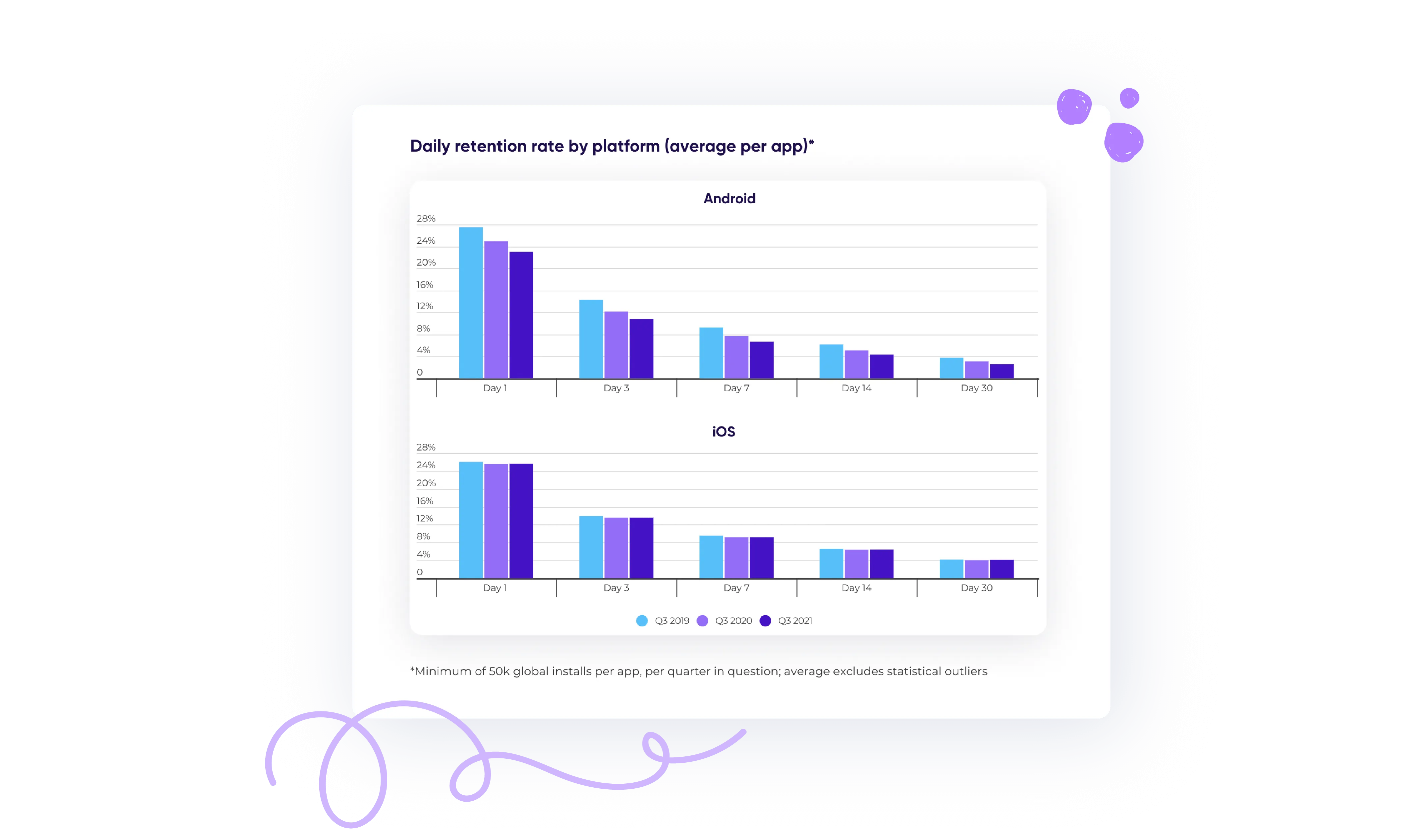

The importance of mobile onboarding
Ready to get started? Great! In this first lesson, we’ll review mobile app retention rates, why they’re so hard to improve, and how mobile app onboarding experiences fit in.

The importance of mobile onboarding
In this first lesson, we’ll review retention rates for mobile apps, why they’re so hard to improve, and how mobile app onboarding experiences fit in.
Let’s do this!
.gif)
Pictured: the Appcues Mobile Team, IRL!
Mobile’s massive short-term retention problem
Getting people to use your mobile app consistently is critical to its long-term success. After all, what’s the point of developing a mobile app if no one uses it?
Unfortunately, the statistics aren’t all sunshine and rainbows. Average new user activation and retention rates on mobile apps are low and getting worse over time.
According to Appsflyer’s 2021 analysis of 6 billion app installs, the average app loses over 75% of new users on day one. By day 30, fewer than 5% of users remain active.
Now consider that most mobile users access fewer than 20 apps per month and spend half of their time using a single app—typically TikTok, Youtube, Google, Snapchat, or Spotify.
Given the hot competition for mobile screen real estate and the thousands of new mobile apps released daily, it’s not surprising short-term user retention rates have declined in recent years. But if you work in the mobile space, the stats probably still give you goosebumps! 👻
Why is mobile so hard?
Before we dive into improving your onboarding experience and fixing your mobile app woes, let’s first look at some of the big, overarching issues within mobile today.
First things first: You can’t think about your mobile app as merely an extension of your website or web app. Attracting and retaining the attention of mobile app users is an incredibly competitive business, and the strategies that brought you success on the web don’t always translate to mobile.
There’s simply a lot more friction involved in mobile adoption. Think about the process of downloading an app for the first time. First, you’ve got to learn about the app—what it’s called, what it does, why it’s worth your time and money—then find it in your phone’s app store, then grant approval for the app to take up precious real estate on your phone, and then finally download it to your device.
That’s a lot of hoops to jump through before you even open an app for the first time.
You might think the effort required to download and install a new mobile app would filter out the least interested folks, resulting in a more intentional and engaged cohort of new users—and it usually does. The problem? Those that do make it through are no more charitable with their time.
Remember that abysmal stat about 1-day mobile app user retention? That’s right—less than 25%. In short, you’ve got one chance to show new users that your app is worth more of their time.
Clutch (a market insights company) found that if an onboarding experience takes longer than 2 minutes, many people just give up altogether. In other words, you have 120 seconds to help your mobile users find value—or lose them forever.

Even if you shelled out for the extra MBs, the storage on your phone is a finite resource. Chances are you’re picky about how you use that space.
The real estate on your users’ phone is equally valuable—so valuable that nearly 20% of users say they’ve deleted an app because they thought the icon was too ugly for their home screen.

In other words: Deliver on your app’s value proposition quickly and efficiently, or users are unlikely to stick around. A swift onboarding is essential for preventing abandonment and retaining your mobile users beyond that first use. (Designing an attractive icon can’t hurt, either.)
The Cambridge Analytica scandal was a Watergate moment for user privacy. Now, making your users feel safe is more important than ever. How and when you ask for personal information and phone access can make or break your user onboarding experience. Being asked to hand over sensitive data or access to your smartphone can be jarring.
As an app user, you might even find yourself wondering:
• “Why does LinkedIn want access to my Bluetooth?”
• “Why is Bitmoji asking for my location?”
• “Why would this rideshare app need access to my camera?”
Your reasons for requiring certain information may seem obvious to you, but if you don’t explain them to your users, they won’t feel safe. And if users don’t trust your app, they’re much more likely to abandon or delete it before they’ve even finished onboarding.
This is where permission priming comes in. We’ll cover this topic more in a later lesson.

Improving mobile onboarding is the key to success
As depressing as the stats can be, there is hope. 64% of millennial users (and 30% of users aged 35 to 54) say they are downloading more apps now than they did a year ago. People are increasingly willing to try new mobile apps. That’s good news for the top of your funnel.
So the key to success—a growing and active mobile user base—is to hook them on day 1 with a stellar onboarding experience.
Luckily for you, this course will teach you just how to do that.







